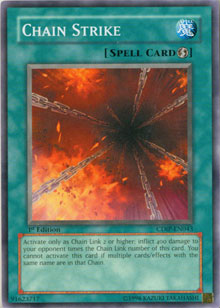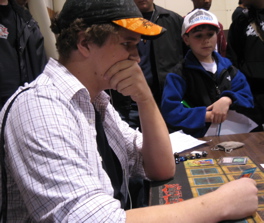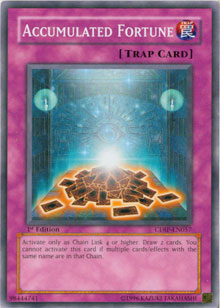Hello loyal readers and welcome to 2007! I hope you all had a great holiday season and a happy New Year. A lot happened this year in the Yu-Gi-Oh! Trading Card Game. Two very different Advanced lists have yielded two very different formats. Power cards have come and gone, deadly OTK cards have been Forbidden or neutered, and the game is ready to start afresh. With the new year comes a new game, and the days of the Cyber-Stein threat are over. However, in its place is a new, equally scary archetype ready to take duelists by surprise and punish those who don’t fully utilize their side decks.
 Chain Strike, Accumulated Fortune, and Chain Detonation created something of a stir upon their release. Many saw the potential of Chain Strike and Accumulated Fortune in a burn deck. After all, the burn deck already plays many chainable cards to deal fast damage, so making these new cards chain link 4 or higher is actually quite easy.
Chain Strike, Accumulated Fortune, and Chain Detonation created something of a stir upon their release. Many saw the potential of Chain Strike and Accumulated Fortune in a burn deck. After all, the burn deck already plays many chainable cards to deal fast damage, so making these new cards chain link 4 or higher is actually quite easy.
However, many people (including the members of Project D and other online communities) considered a new archetype, one made up entirely of cards whose purpose was to burn the opponent. The deck, while new to the Yu-Gi-Oh! TCG, has found success in other card games. They are built on simple math. Given that your opponent has only 8000 life points, if each card in your deck does at least 800 damage, your opponent will be finished after you draw your tenth card. Since you start with five cards, your opponent should be finished off by your fifth turn if he or she is unable to negate or discard any of your cards before you use them.
Of course, this means you have to survive for five turns. Assuming that you play almost zero defensive cards, you will most certainly fall to an opponent who summons big beaters every turn to hit your life points. This is where the deck takes advantage of the current metagame and the average player’s approach to the game. Most of the monsters people use today have very small ATK values. Think Apprentice Magician, Treeborn Frog, and Sangan. The popular monsters that do have high ATK usually require the opponent to have a monster on the field, such as Cyber Dragon or Zaborg the Thunder Monarch. Other monsters (such as Dekoichi the Battlechanted Locomotive and Exiled Force) simply won’t be played to attack immediately, simply because there are other things that you typically want to do with them.
Players will also be unwilling to make aggressive plays against a seemingly defensive opponent. An opponent unaware of the new Chain Burn archetype probably won’t summon Mystic Tomato or Breaker the Magical Warrior when you have three face-down spells or traps. The likelihood of his or her monsters being destroyed without getting their effects off is too great, and most players would rather set a flip effect or wait until they can draw a floater to take on what appears to be a defense-heavy draw. However, playing passively is exactly what the Chain Burn archetype wants to see, and usually—before the opponent can realize his or her mistake—the Chain Burn player has drawn into enough cards to end the game first.
Though two Chain Burn decks made the Top 8 of Shonen Jump San Jose, I chose to review this build:
Spells: 11
3 Poison of the Old Man
3 Tremendous Fire
3 Chain Strike
1 Graceful Charity
1 Scapegoat
Traps: 30
3 Accumulated Fortune
3 Secret Barrel
3 Just Desserts
3 Jar of Greed
3 Fire Darts
2 Reckless Greed
2 Ojama Trio
2 Chain Detonation
1 Waboku
1 Threatening Roar
1 Gravity Bind
1 Ring of Destruction
1 Magic Cylinder
1 Ceasefire
2 Dimension Wall
 This particular build decided to pass on playing any monsters at all, which is why it caught my eye. Though it seems risky, it actually increases the likelihood of an opponent having no monsters to attack with. Although you have no monsters with which to protect your life points, your opponent has no easy way to effectively play his or her Cyber Dragon, Zaborg the Thunder Monarch, or Soul Exchange/Thestalos the Firestorm Monarch cards. Nobleman of Crossout, along with any other piece of monster-only removal, is also neutralized.
This particular build decided to pass on playing any monsters at all, which is why it caught my eye. Though it seems risky, it actually increases the likelihood of an opponent having no monsters to attack with. Although you have no monsters with which to protect your life points, your opponent has no easy way to effectively play his or her Cyber Dragon, Zaborg the Thunder Monarch, or Soul Exchange/Thestalos the Firestorm Monarch cards. Nobleman of Crossout, along with any other piece of monster-only removal, is also neutralized.
Although Mecha-Dog Marron can usually inflict 1000 damage in any given situation, it’s mathematically unnecessary for the deck. Causing only 200 damage more than a simpler card like Ookazi is not worth the risk against an opponent’s Cyber Dragon, Soul Exchange, Nobleman of Crossout, or Zaborg the Thunder Monarch. These cards nullify the extra damage by either negating the card full-out (as in the case of the two spell cards), or by putting up monsters that force you to win with fewer draws because of the threat to your life points.
Two monsters that can be considered are Morphing Jar and Lava Golem. It goes without saying that if Morphing Jar goes off, the Chain Burn player will likely win the game. An effective Morphing Jar means you’ve seen at least ten cards, and as long as each one does an average of 800 damage, you’ll win. Project D decided that the risk of opposing negation was too high, and that only unlucky opponents would lack an answer to Morphing Jar.
Lava Golem will almost certainly deal 1000 damage, especially in games 2 and 3 when the opponent has likely side decked out as much monster removal as possible (including all copies of Bottomless Trap Hole and possibly Torrential Tribute). In addition, players will probably attack with it before trying to rid it from the field via their own tribute monsters or removal effects—which will make your Dimension Wall, Magic Cylinder, or Ring of Destruction that much stronger. If your opponent doesn’t have two monsters on the field, and you don’t have an Ojama Trio to force Lava Golem on him or her, then your opponent probably isn’t able to deal enough damage to you to make the one dead card you have matter anyway.
The best way to evaluate the cards in the deck is to compare them to the effect of Ookazi. Does the card generate at least 800 damage, and does its potential cover the risk of it being dead or not dealing enough damage?
Taking a look at what the deck plays, we see a hefty amount of direct burn cards that deal at least 800 damage: Tremendous Fire, Poison of the Old Man, and Chain Strike, for example. In addition, cards like Just Desserts, Secret Barrel, Fire Darts, Chain Detonation, Ring of Destruction, and Ceasefire will likely deal at least 1000 damage. Each one of these cards will almost always be chainable, and act as the core cards of the deck.
 Draw cards are the next group added to the deck. Graceful Charity balances out a hand that would otherwise have too many specific or un-chainable cards to make necessary chains. Accumulated Fortune doesn’t deal any damage itself, but it will likely draw into cards that generate more than 800 damage. The same can be said of Reckless Greed, which actually slows down the speed at which you draw cards by one turn. But if you’re able to use it when both players are low on life points, the one-turn-ahead draw can make the difference. Additionally, its freedom of chainability can be invaluable.
Draw cards are the next group added to the deck. Graceful Charity balances out a hand that would otherwise have too many specific or un-chainable cards to make necessary chains. Accumulated Fortune doesn’t deal any damage itself, but it will likely draw into cards that generate more than 800 damage. The same can be said of Reckless Greed, which actually slows down the speed at which you draw cards by one turn. But if you’re able to use it when both players are low on life points, the one-turn-ahead draw can make the difference. Additionally, its freedom of chainability can be invaluable.
The more risky cards in the deck are the ones that aren’t chainable. Dimension Wall and Magic Cylinder each require the opponent to make an attack before they can do any damage. As such, they are vulnerable to spell and trap removal and, if destroyed, force you to take an additional turn before drawing enough cards to finish an opponent. However, if successfully played, these cards can create as much as a 4800 point spread in life points, saving you 2400 damage and dealing 2400 damage the other way. This kind of payoff was worth it to the Project D team.
Finally, we have the fourth group of cards played in the deck. The stall cards provide an extra turn to draw cards for both players. The theory behind this is that your draw will likely yield another burn card anyway. If your Waboku was a Ookazi, and the next card on top of your deck is a Secret Barrel, than the Waboku would eventually cause your opponent to take more damage. The same goes for Threatening Roar. While it doesn’t matter which of these cards you play, you may need to chain both in the same chain at some point to get your chain link 4 cards off. As such, playing one of each eliminates the possibility of limiting your own chain with same-name cards.
Gravity Bind and Scapegoat are dependent on your opponent’s cards. Gravity Bind is vulnerable to spell and trap removal, while Scapegoat can be countered by Enemy Controller or Asura Priest. However, the odds of these cards stalling for at least one turn is very high, and they can possibly stall for two or three turns before they’re eliminated from the field. Each turn you stall translates into an extra draw with which to burn the opponent. Since they are both chainable, the risk is definitely worth taking.
Ojama Trio is the only combo-based card in the deck. However, when used in conjunction with Just Desserts, it produces an extra 1500 damage, an extra 600 when combined with Secret Barrel, or 900 damage if your opponent uses a Torrential Tribute. Additionally, locking down an opponent with low ATK monsters means you’ll minimize the amount of damage you take. Also, two Ojama Trio cards and Ring of Destruction can completely lock the opponent’s field, meaning you have as many turns as you need to draw enough burn damage and force through game.
This deck is all in the building. Once you know what your plan is for the game, making your moves is quite simple. Eliminate as many of the opponent’s options as possible, force through as much damage as you can, and know how to chain all your cards. This deck will reward those who playtest often and punish players who aren’t ready with their side decks. Don’t expect it to disappear from the public eye just yet: keep your side decks fully loaded with Des Wombat, Royal Decree, and Emergency Provisions.
Congratulations to Tomas Mijares and Geoffery Fisicaro for making the Top 8 of the Shonen Jump with strong Chain Burn decks of their own, and congratulations to Project D for a spectacular performance and some excellent finishes.